Determination of Self-Neutralization Phenomena of Ion Beams with Langmuir Probe Measurements and PIC-DSMC Simulations
Abstract
:1. Introduction
2. Methodology
2.1. Experimental and Diagnostic Approach
2.1.1. Probe Diagnostics
2.1.2. SSG and Grid Currents
2.2. Numerical Approach
2.2.1. Neutral Phase Modeling
2.2.2. Plasma Modeling
3. Results and Discussion
3.1. Experimental Measurements
3.1.1. Plasma Potential
- 1.
- Filament is heated and kept floating → uncompensated (UC) beam.
- 2.
- Filament is heated and allowed to source up to 1 mA of electrons, effectively reducing the total electric current emitted by the SSG → partially compensated (PC) beam.
Uncompensated Beam
Partially Compensated Beam
3.1.2. Plasma Parameters
3.1.3. Partially Compensated Beam Number Densities
3.2. SSG Current and Beam Neutralization
3.3. Numerical Modeling
4. Conclusions
Author Contributions
Funding
Institutional Review Board Statement
Informed Consent Statement
Data Availability Statement
Acknowledgments
Conflicts of Interest
References
- Riege, H. Neutralization principles for the extraction and transport of ion beams. Nucl. Instruments Methods Phys. Res. Sect. A Accel. Spectrometers Detect. Assoc. Equip. 2000, 451, 394–405. [Google Scholar] [CrossRef]
- Goebel, D.M.; Katz, I. Ion Thruster Accelerator Grids. In Fundamentals of Electric Propulsion; Chapter 5; John Wiley and Sons, Ltd.: Hoboken, NJ, USA, 2008; pp. 189–241. [Google Scholar] [CrossRef]
- Demidov, V.I.; Ratynskaia, S.V.; Rypdal, K. Electric probes for plasmas: The link between theory and instrument. Rev. Sci. Instruments 2002, 73, 3409–3439. [Google Scholar] [CrossRef]
- Lobbia, R.B.; Beal, B.E. Recommended practice for use of Langmuir probes in electric propulsion testing. J. Propuls. Power 2017, 33, 566–581. [Google Scholar] [CrossRef]
- Sheenan, J.P.; Raitses, Y.; Hershkowitz, N.; McDonald, M. Recommended practice for use of emissive probes in electric propulsion testing. J. Propuls. Power 2017, 33, 614–637. [Google Scholar] [CrossRef]
- Godyak, V.A.; Alexandrovich, B.M. Comparative analyses of plasma probe diagnostics techniques. J. Appl. Phys. 2015, 118, 233302. [Google Scholar] [CrossRef]
- Li, P.; Hershkowitz, N.; Wackerbarth, E.; Severn, G. Experimental studies of the difference between plasma potentials measured by Langmuir probes and emissive probes in presheaths. Plasma Sources Sci. Technol. 2020, 29, 025015. [Google Scholar] [CrossRef]
- Kemp, R.F.; Sellen, J.M., Jr. Plasma Potential Measurements by Electron Emissive Probes. Rev. Sci. Instruments 2004, 37, 455–461. [Google Scholar] [CrossRef]
- Smith, J.R.; Hershkowitz, N.; Coakley, P. Inflection-point method of interpreting emissive probe characteristics. Rev. Sci. Instruments 2008, 50, 210–218. [Google Scholar] [CrossRef] [PubMed]
- Brandt, C.; Testrich, H.; Kozakov, R.; Wilke, C. Investigation of the disturbance of a Langmuir probe and its influence on measurement results. Rev. Sci. Instruments 2006, 77, 023504. [Google Scholar] [CrossRef]
- Haas, J.; Spabjers, G.; McFall, K.; Spores, R. An investigation of electrostatic probe perturbations on the operational characteristics of a Hall thruster and on the measurement of local plasma parameters. In Proceedings of the 34th AIAA/ASME/SAE/ASEE Joint Propulsion Conference and Exhibit, Cleveland, OH, USA, 13–15 July 1998. [Google Scholar] [CrossRef]
- Arthur, N.A.; Williams, G.J. Near field probe measurements in the plume of a NEXT ion thruster. In Proceedings of the 36th International Electric Propulsion Conference, Vienna, Austria, 15–20 September 2019; p. 167. [Google Scholar]
- de Boer, P.C.T. Electric probe measurements in the plume of an ion thruster. J. Propuls. Power 1996, 12, 95–104. [Google Scholar] [CrossRef]
- Zhang, Z.; Tang, H.; Ren, J.; Zhang, Z.; Wang, J. Calibrating ion density profile measurements in ion thruster beam plasma. Rev. Sci. Instruments 2016, 87, 113502. [Google Scholar] [CrossRef]
- Zhang, Z.; Tang, H.; Kong, M.; Zhang, Z.; Ren, J. Electron temperature measurement in Maxwellian non-isothermal beam plasma of an ion thruster. Rev. Sci. Instruments 2015, 86, 023506. [Google Scholar] [CrossRef] [PubMed]
- Bird, G.A. The DSMC Method; Version 1.2; CreateSpace: Scotts Valley, CA, USA, 2013. [Google Scholar]
- Boyd, I.D.; Van Gilder, D.B.; Liu, X. Monte Carlo Simulation of Neutral Xenon Flows in Electric Propulsion Devices. J. Propuls. Power 1998, 14, 1009–1015. [Google Scholar] [CrossRef]
- Jambunathan, R.; Levin, D.A. A Self-Consistent Open Boundary Condition for Fully Kinetic Plasma Thruster Plume Simulations. IEEE Trans. Plasma Sci. 2020, 48, 610–630. [Google Scholar] [CrossRef]
- Brieda, L. Development of the DRACO ES-PIC Code and Fully-Kinetic Simulation of Ion Beam Neutralization. Master’s Thesis, Virginia Polytechnic Institute and State University, Blacksburg, VA, USA, 2005. [Google Scholar]
- Feili, D.; Smirnova, M.; Dobkevicius, M.; Perez, A.M.; Lotz, B.; Collingwood, C. Design, construction and testing of a radio frequency mini ion engine according to the propulsion requirements of the next generation graviity mission “NGGM”. In Proceedings of the 34th International Electric Propulsion Conference, Hyogo-Kobe, Japan, 4–10 July 2015; p. 277. [Google Scholar]
- Ortwein, P.; Copplestone, S.; Munz, C.D.; Binder, T.; Mirza, A.; Nizenkov, P.; Pfeiffer, M.; Reschke, W.; Fasoulas, S. Piclas: A Highly Flexible Particle Code for the Simulation of Reactive Plasma Flows. In Proceedings of the 2017 IEEE International Conference on Plasma Science (ICOPS), Atlantic City, NJ, USA, 21–25 May 2017. [Google Scholar] [CrossRef]
- Fasoulas, S.; Munz, C.D.; Pfeiffer, M.; Beyer, J.; Binder, T.; Copplestone, S.; Mirza, A.; Nizenkov, P.; Ortwein, P.; Reschke, W. Combining particle-in-cell and direct simulation Monte Carlo for the simulation of reactive plasma flows. Phys. Fluids 2019, 31, 072006. [Google Scholar] [CrossRef]
- Pfeiffer, M.; Hindenlang, F.; Binder, T.; Copplestone, S.; Munz, C.D.; Fasoulas, S. A particle-in-cell solver based on a high-order hybridizable discontinuous Galerkin spectral element method on unstructured curved meshes. Comput. Methods Appl. Mech. Eng. 2019, 349, 149–166. [Google Scholar] [CrossRef]
- Bird, G. Molecular Gas Dynamics and the Direct Simulation of Gas Flows; Clarendon Press: Oxford, UK, 1994. [Google Scholar]
- Padilla, J.F.; Boyd, I.D. Assessment of Gas-Surface Interaction Models for Computation of Rarefied Hypersonic Flow. J. Thermophys. Heat Transf. 2009, 23, 96–105. [Google Scholar] [CrossRef]
- Institute for Aerodynamics and Gas Dynamics (University of Stuttgart); Institute for Space Systems (University of Stuttgart). PICLas Documentation. User Guide. Available online: https://piclas.readthedocs.io (accessed on 10 November 2023).
- Habl, L.; Rafalskyi, D.; Lafleur, T. Secondary electron emission due to multi-species iodine ion bombardment of different target materials. J. Appl. Phys. 2021, 129, 153302. [Google Scholar] [CrossRef]
- Binder, T. Development and Application of PICLas for Combined Optic-/Plume-Simulation of Ion-Propulsion Systems. Ph.D. Thesis, University of Stuttgart, Stuttgart, Germany, 2019. [Google Scholar] [CrossRef]
- Bohdansky, J. A universal relation for the sputtering yield of monatomic solids at normal ion incidence. Nucl. Instruments Methods Phys. Res. Sect. B Beam Interact. Mater. Atoms 1984, 2, 587–591. [Google Scholar] [CrossRef]
- Tartz, M.; Heyn, T.; Bundesmann, C.; Zimmermann, C.; Neumann, H. Sputter yields of Mo, Ti, W, Al, Ag under xenon ion incidence. Eur. Phys. J. D 2011, 61, 587–592. [Google Scholar] [CrossRef]
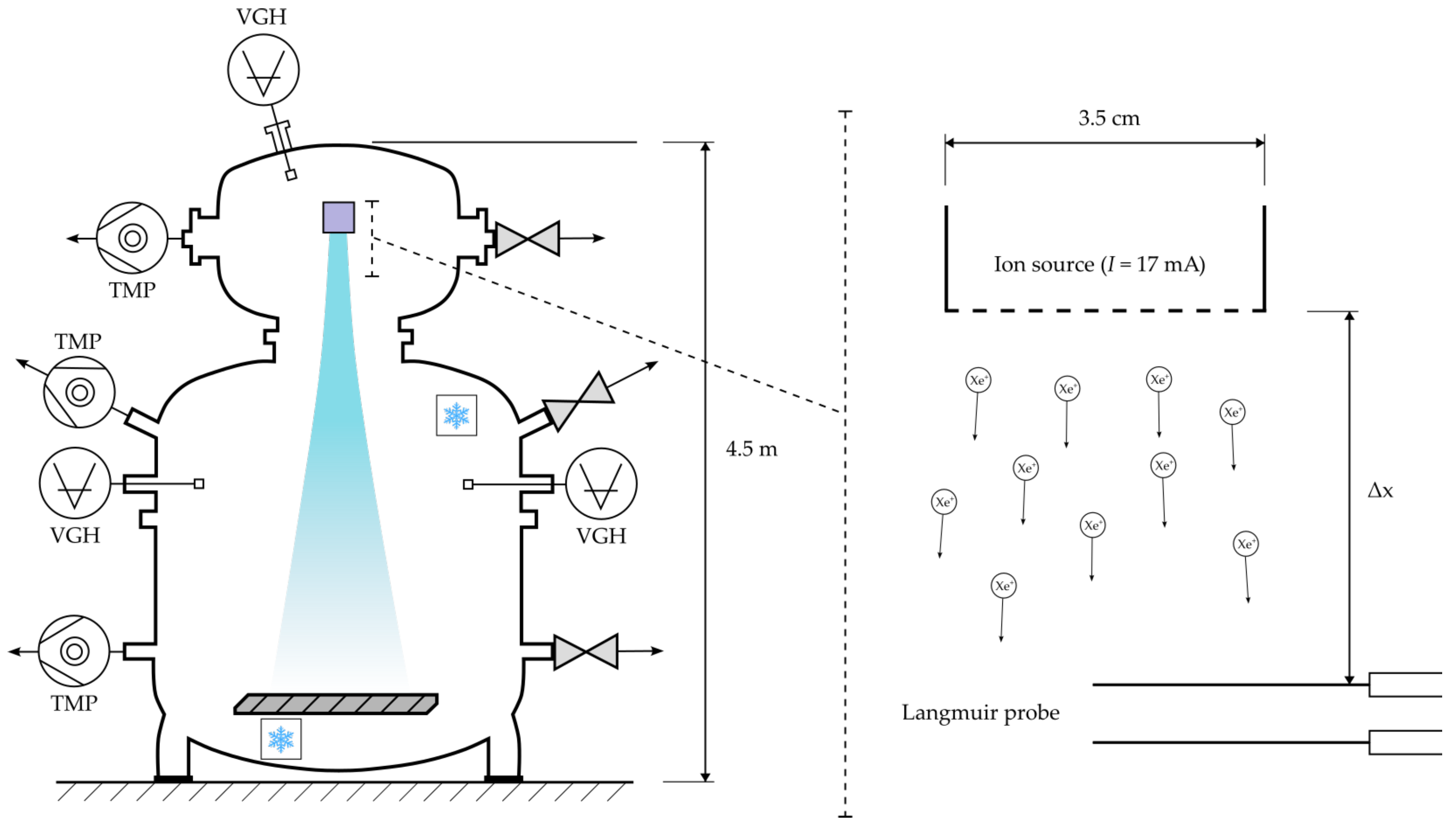



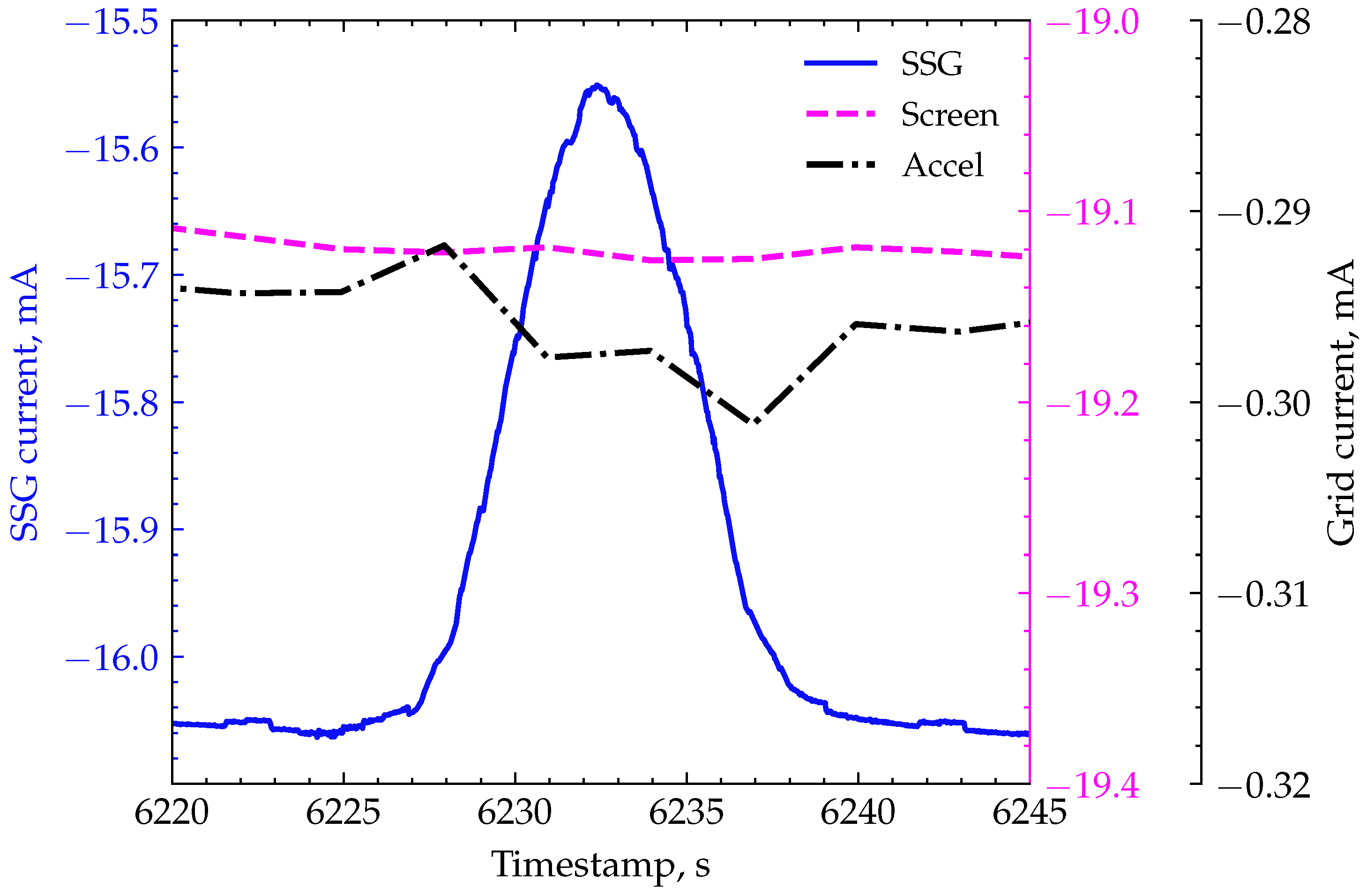
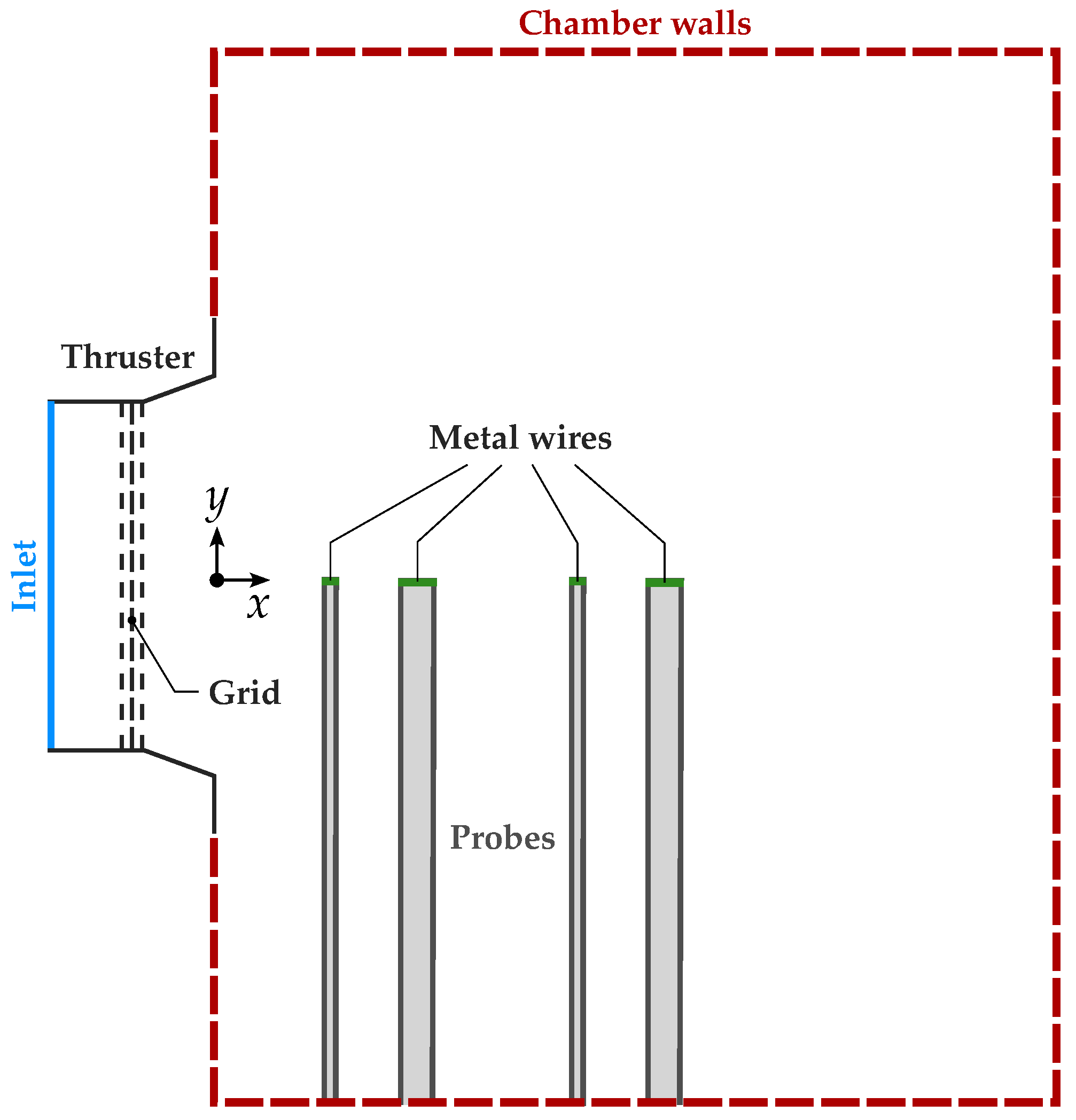

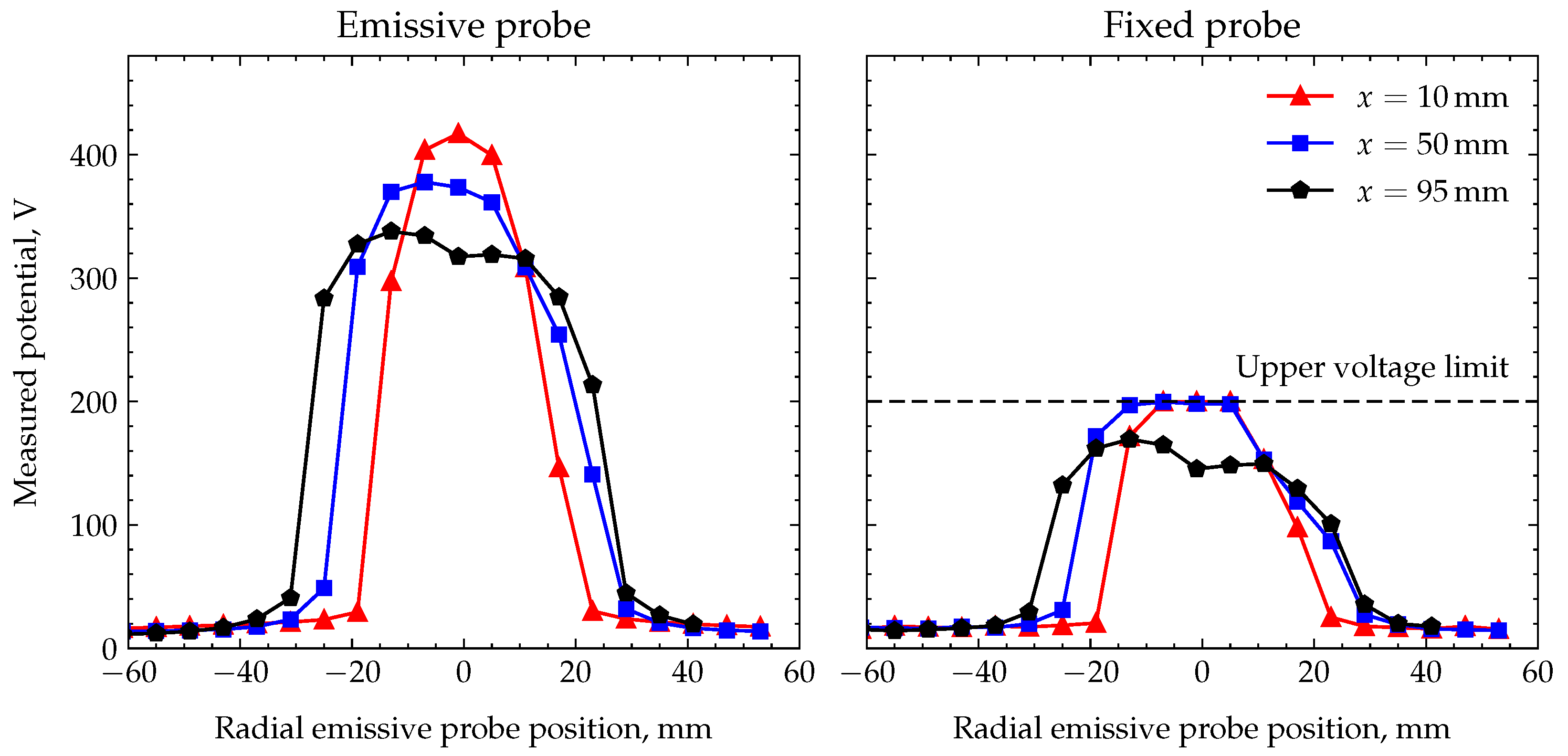
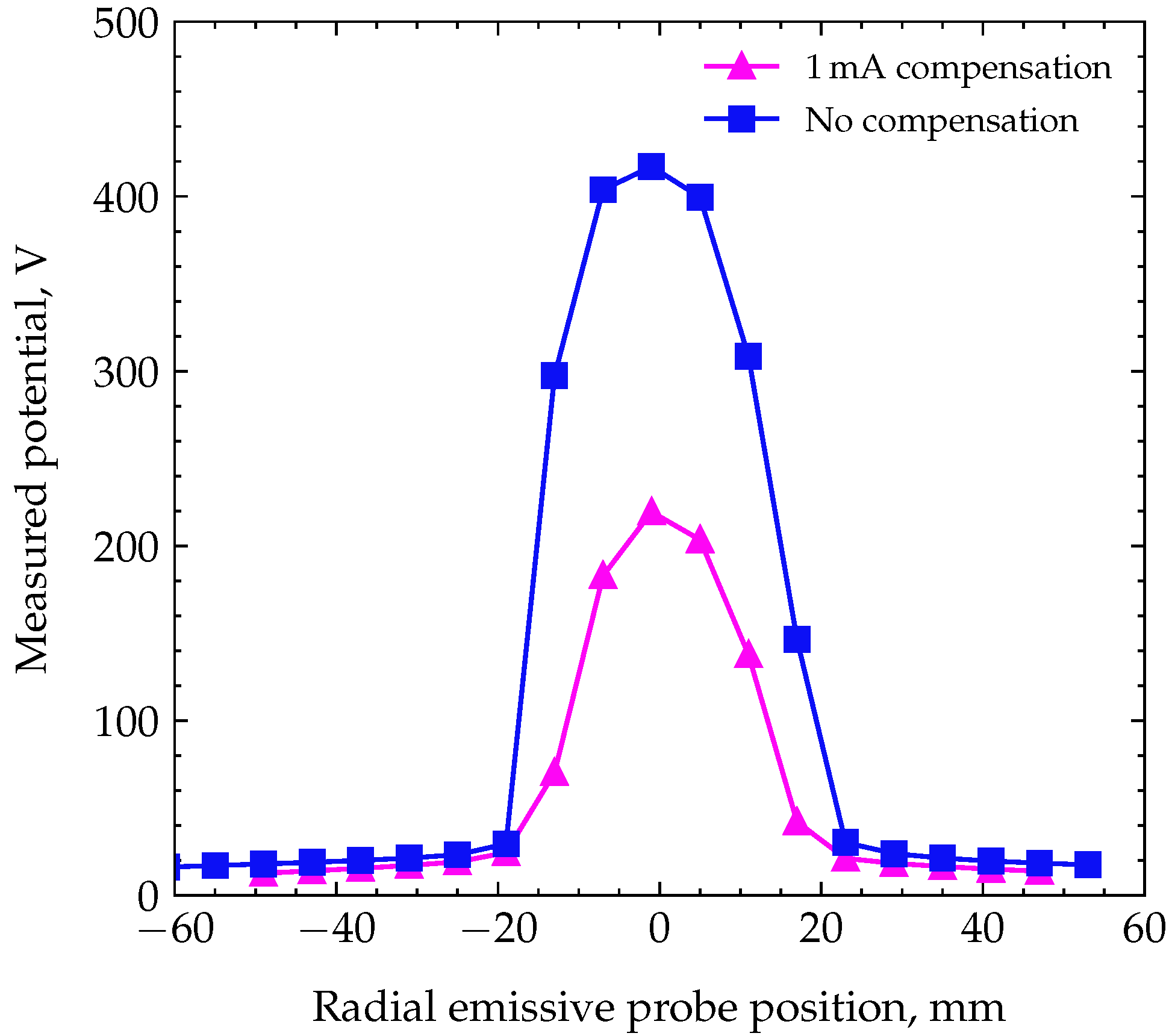
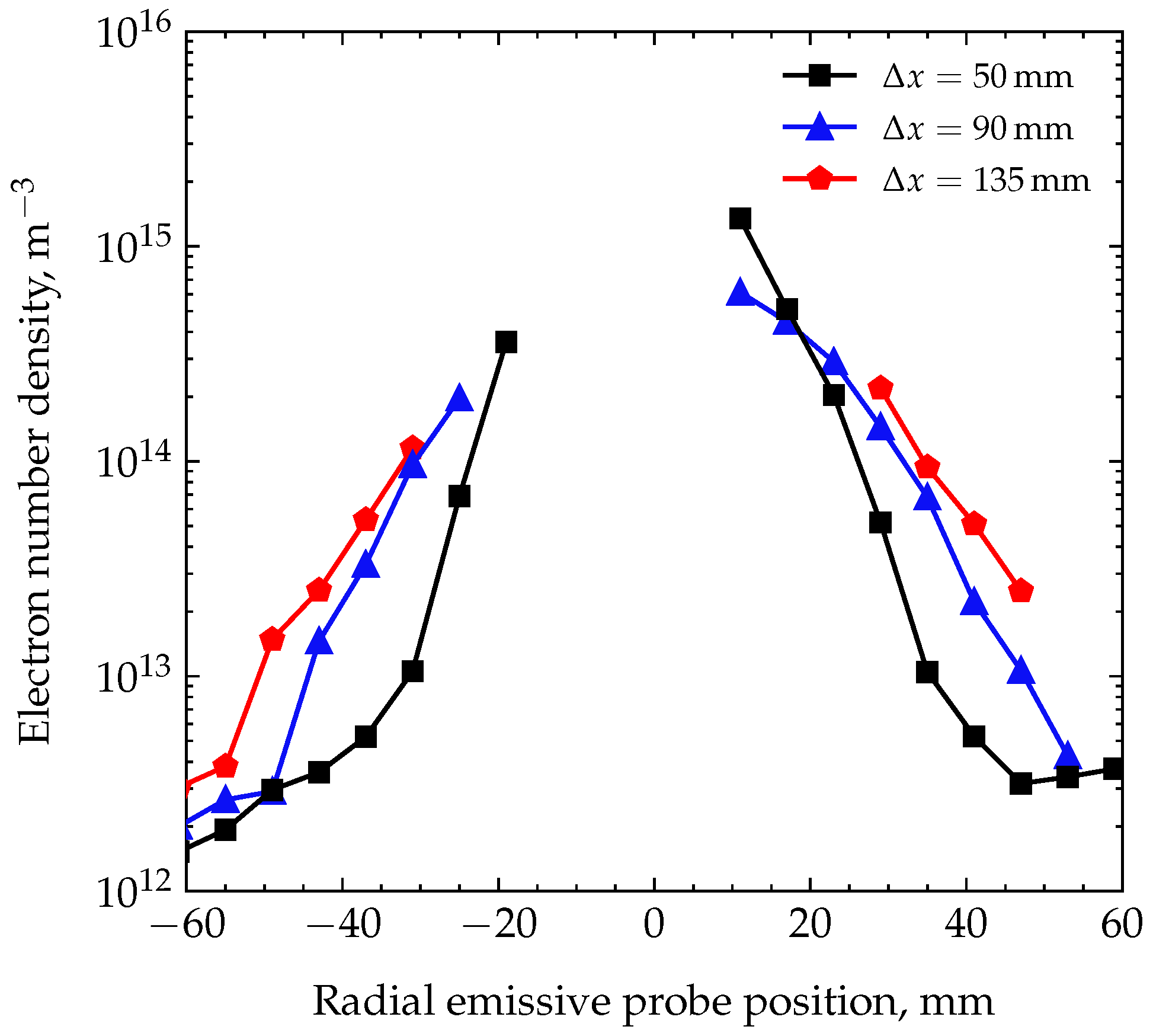

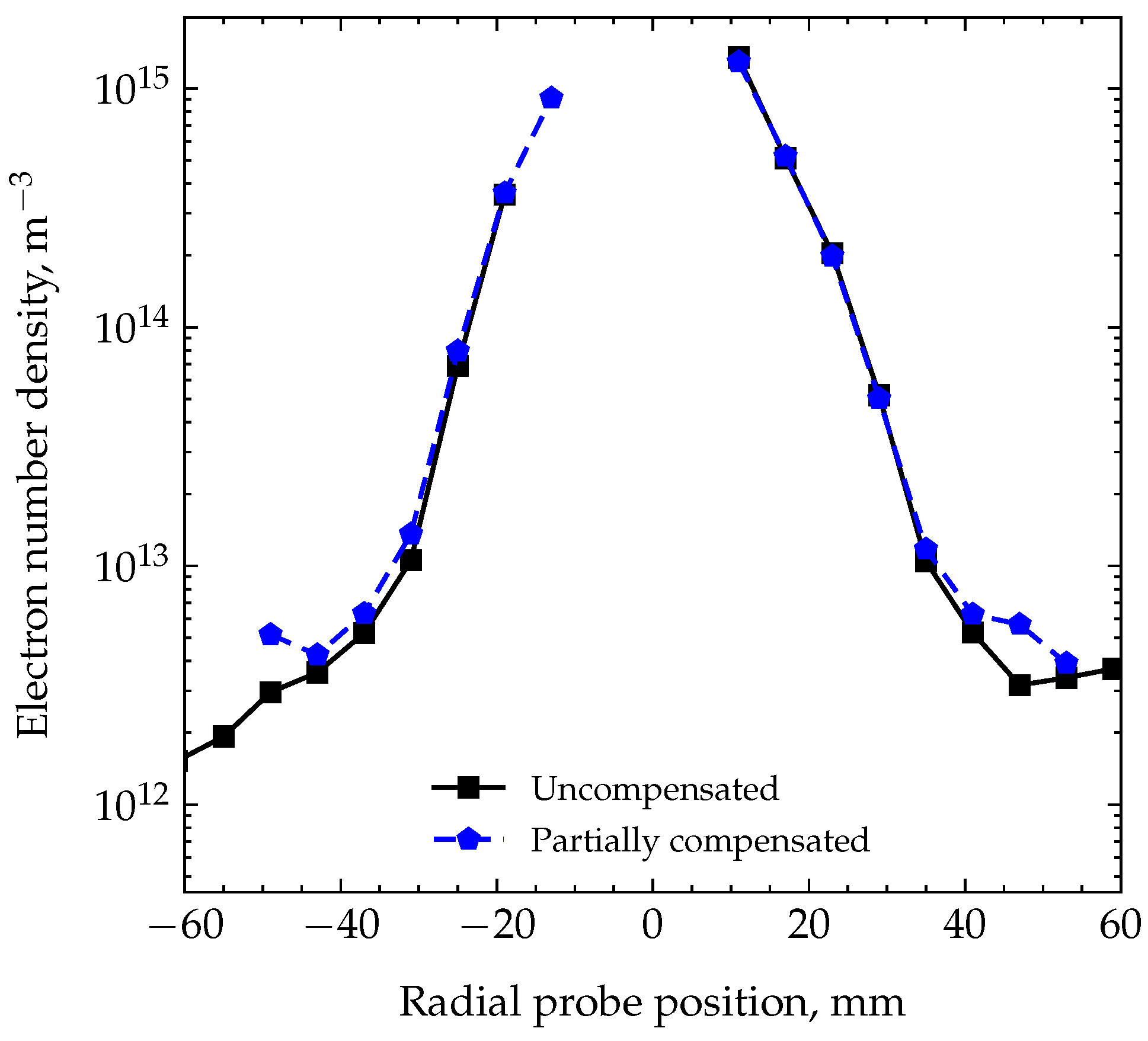
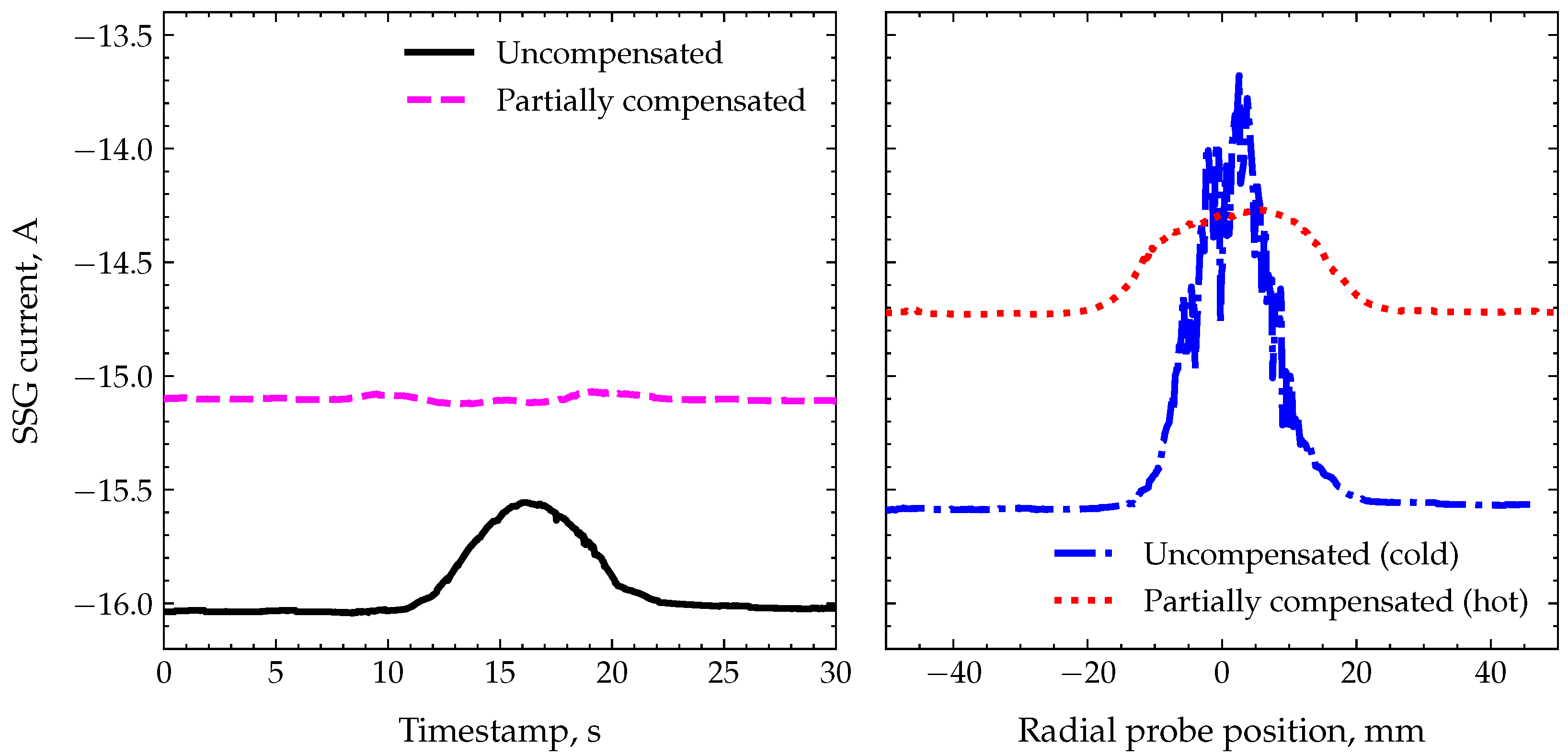
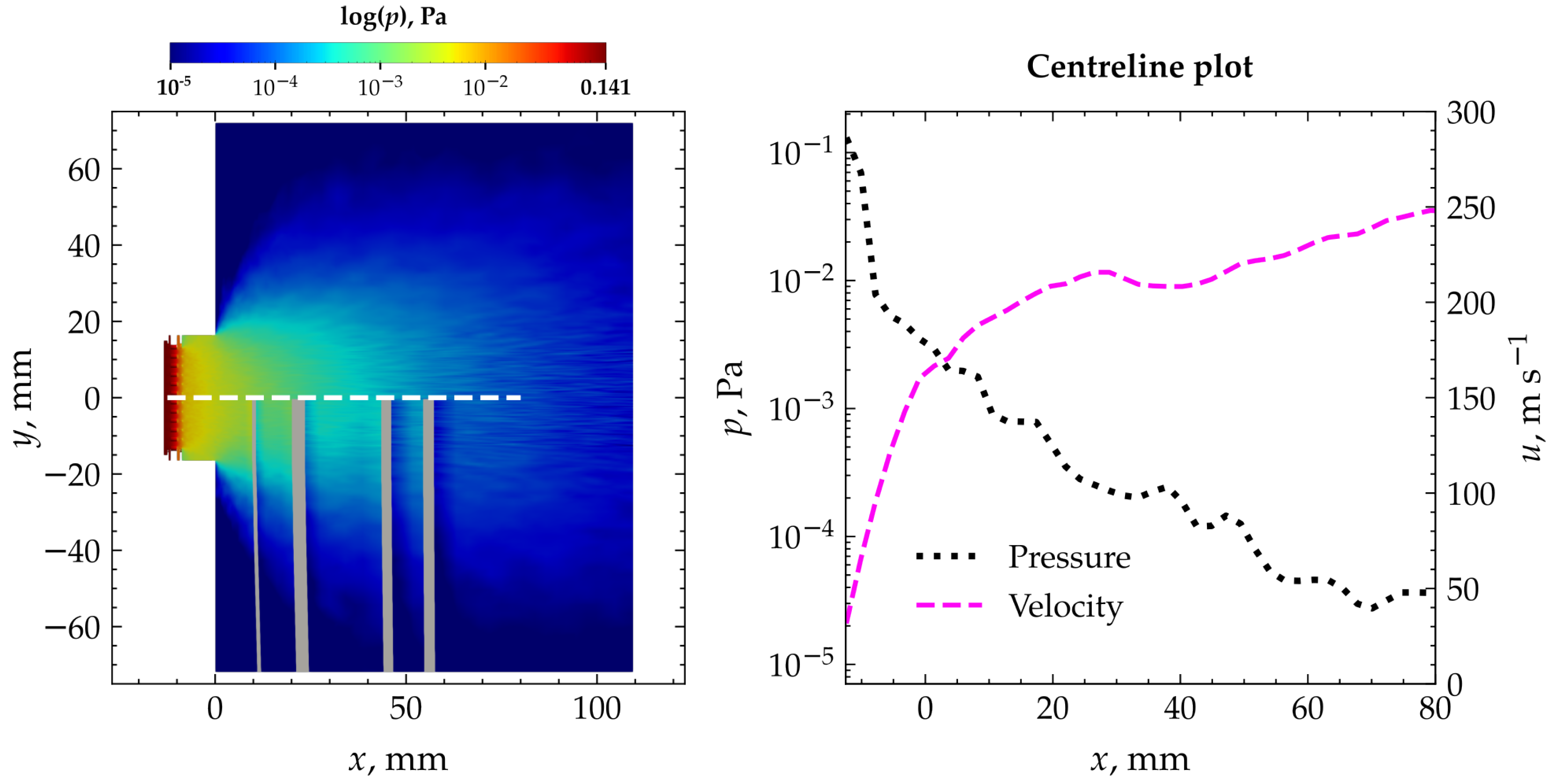
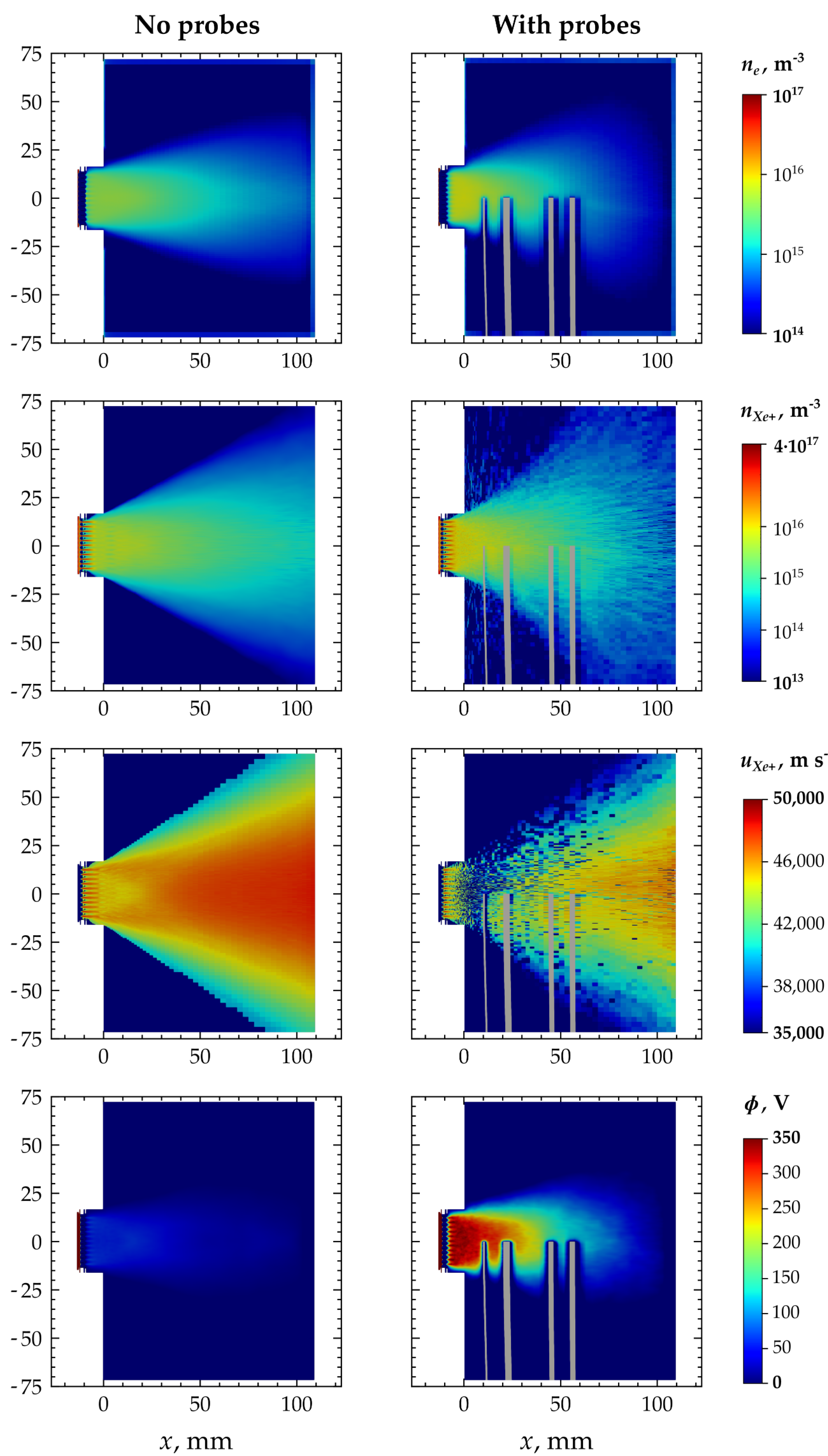
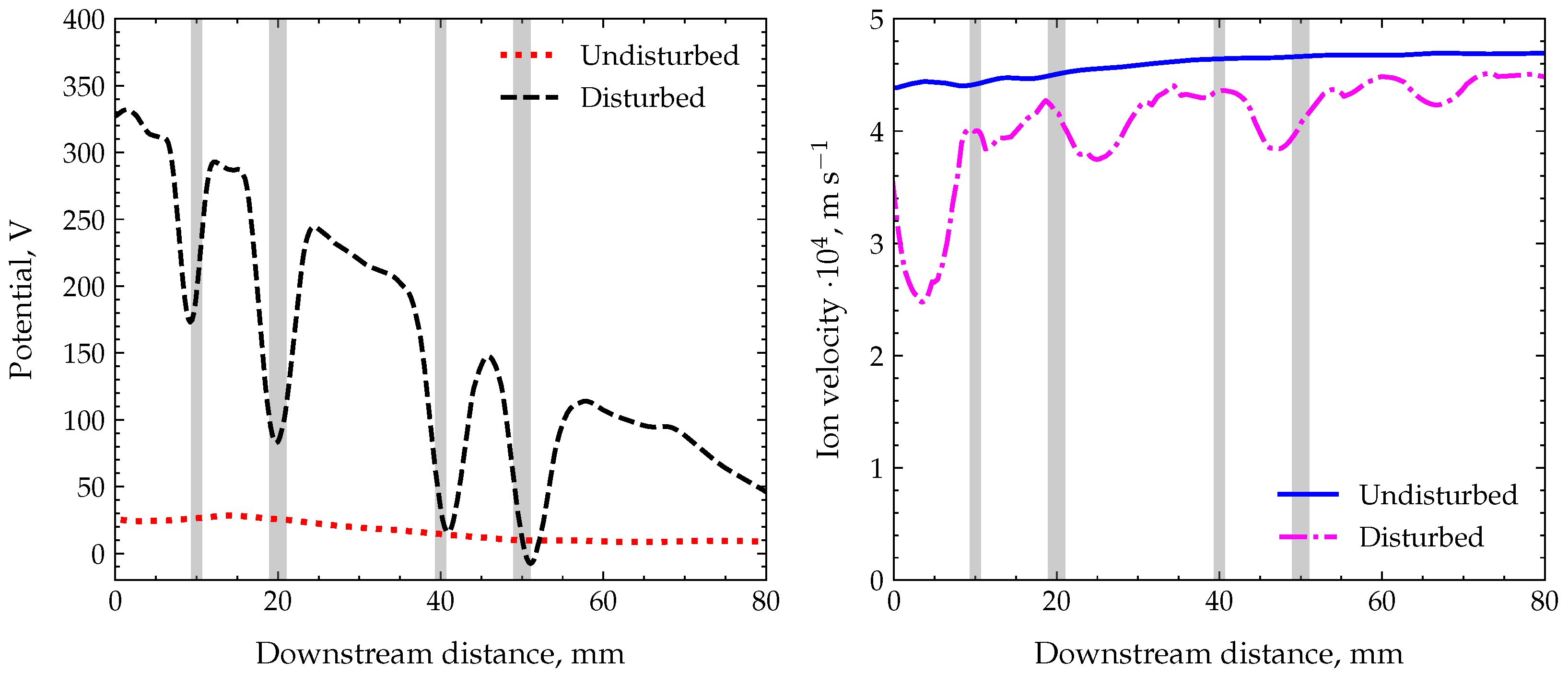

| BC Name | Boundary Condition |
|---|---|
| Inlet | m s−1, K, |
| Thruster walls | Diffusive reflecting wall with and extended Maxwellian model according to [25] |
| Vacuum chamber | Open boundary condition (every crossing particle is removed) |
| Probes | Specularly reflecting wall |
| Name | Field BC | Particle BC |
|---|---|---|
| Inlet | : , u = 1600 m s−1, | |
| e−: , | ||
| Thruster | All species are removed when crossing this BC. | |
| Chamber | All species are removed when crossing this BC. Ions produce a yield of e− based on their impact energy. | |
| Floating probes (metal wire) | Floating BC (See [26] for implementation details.) | All species are removed when crossing this BC, and they leave their charge behind. |
| Dielectrics (probe mounts) | All species are removed when crossing this BC, and they leave their charge behind. |
Disclaimer/Publisher’s Note: The statements, opinions and data contained in all publications are solely those of the individual author(s) and contributor(s) and not of MDPI and/or the editor(s). MDPI and/or the editor(s) disclaim responsibility for any injury to people or property resulting from any ideas, methods, instructions or products referred to in the content. |
© 2024 by the authors. Licensee MDPI, Basel, Switzerland. This article is an open access article distributed under the terms and conditions of the Creative Commons Attribution (CC BY) license (https://creativecommons.org/licenses/by/4.0/).
Share and Cite
Kozakov, R.; Maigler, M.; Schein, J.; Wallace, N. Determination of Self-Neutralization Phenomena of Ion Beams with Langmuir Probe Measurements and PIC-DSMC Simulations. Appl. Sci. 2024, 14, 3470. https://doi.org/10.3390/app14083470
Kozakov R, Maigler M, Schein J, Wallace N. Determination of Self-Neutralization Phenomena of Ion Beams with Langmuir Probe Measurements and PIC-DSMC Simulations. Applied Sciences. 2024; 14(8):3470. https://doi.org/10.3390/app14083470
Chicago/Turabian StyleKozakov, Ruslan, Maximilian Maigler, Jochen Schein, and Neil Wallace. 2024. "Determination of Self-Neutralization Phenomena of Ion Beams with Langmuir Probe Measurements and PIC-DSMC Simulations" Applied Sciences 14, no. 8: 3470. https://doi.org/10.3390/app14083470





